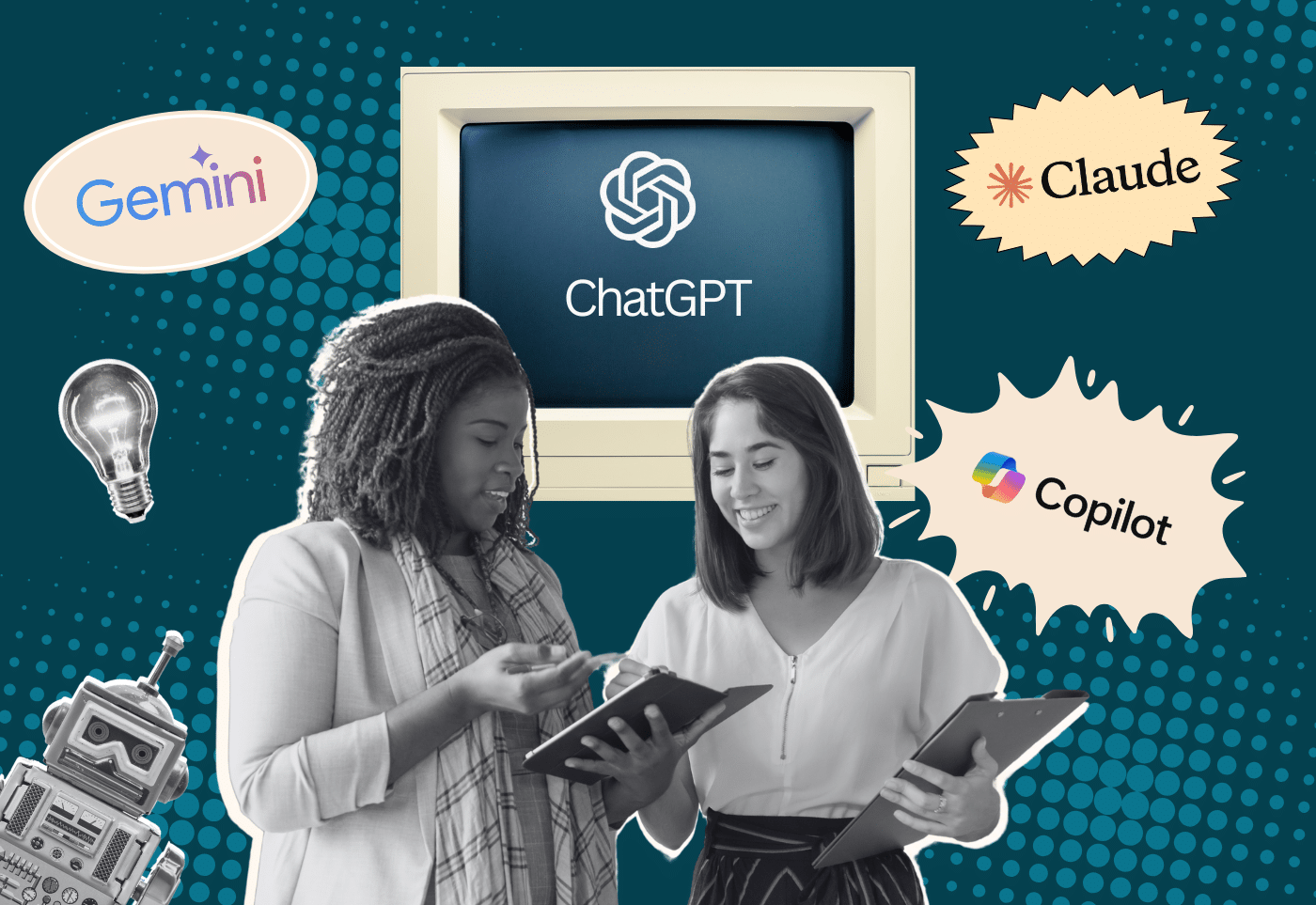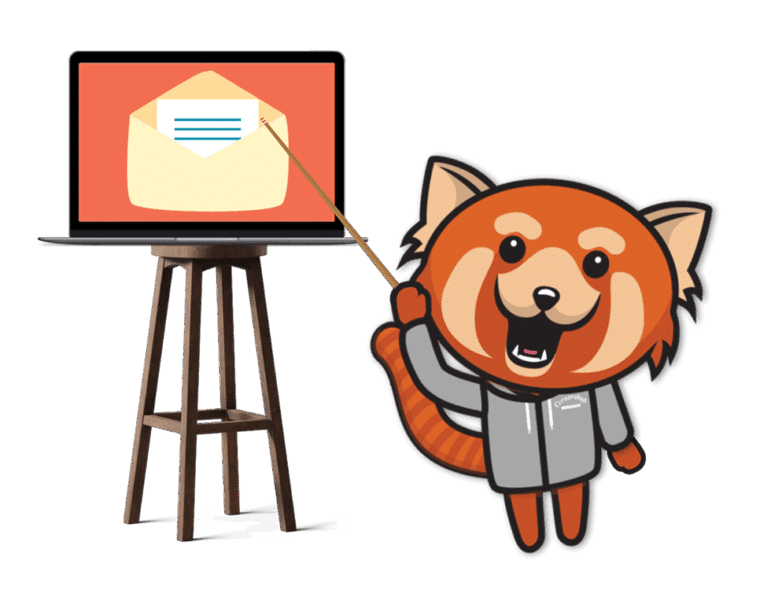At any given time, your nonprofit has several areas of your mission that require attention. You might need to raise funds for a new program, engage supporters in your advocacy work, or increase awareness about the latest research related to your cause. Nonprofit campaigns are the perfect multitools for accomplishing these goals.
In this guide, we’ll cover everything you need to know to launch impactful campaigns for your nonprofit, including:
- Nonprofit Campaigns: Frequently Asked Questions
- Top 4 Nonprofit Campaign Examples
- Best Practices for Nonprofit Campaigns
You can run various campaigns, each with individual branding and objectives, so you never have to choose just one area to concentrate your efforts on. Let’s get started.
Let’s Chat About Your Project!
Nonprofit Campaigns: Frequently Asked Questions
Campaigns are integral to your nonprofit’s long-term success and sustainability. But what exactly is a nonprofit campaign and how do you plan an effective one? Let’s jump into some of the most frequently asked questions about nonprofit campaigns.
What is a nonprofit campaign?
A nonprofit campaign refers to an organized effort that charitable organizations take to raise revenue, engage supporters, or fulfill other goals related to their mission. To inspire participation and maximize results, nonprofits often use various marketing methods to promote these campaigns, such as:
- Emails
- Social media posts
- Flyers
- Petitions
- Website landing pages
Many nonprofits partner with marketing experts, such as Cornershop Creative’s web design specialists, to produce custom landing pages and other engaging content that will help them unlock more support for their campaigns. This way, they can rely on years of sector-specific experience while saving time and effort that their team can spend elsewhere.
Are there different types of nonprofit campaigns?
There are numerous nonprofit campaigns that your organization could implement. Depending on your specific strategy and goals, these are some of the most popular nonprofit campaign types you could embark on:
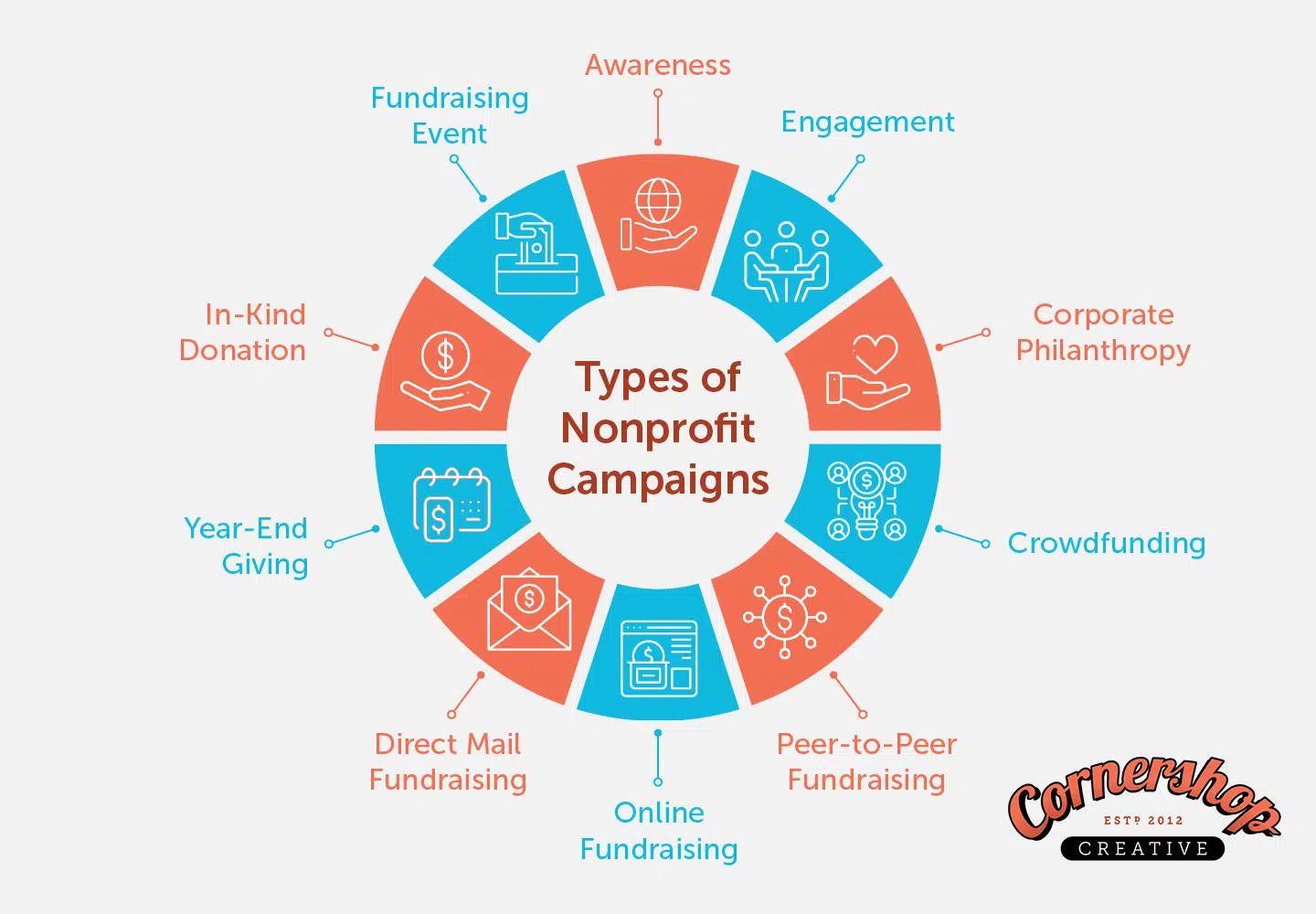
Awareness Campaign
Is there something happening with your cause that people need to know about? Maybe a new study was freshly released or a major event is making national news. If so, your nonprofit might start an awareness campaign to:
- Educate the public about your cause and recent developments around it.
- Increase your visibility and expand your reach to new audience members.
- Encourage existing supporters to get more deeply involved.
Your nonprofit must employ a combination of marketing tactics to get in front of as many people as possible. At Cornershop Creative, our team has extensive expertise in search engine optimization (SEO), email marketing, and content strategy creation. We know what it takes to catch people’s attention and stand out from all the online noise.
Recently, we helped the Oblates of the Virgin Mary (OMV) leverage a variety of online channels, from social media to email marketing, to boost their website traffic and engage their audience.

Engagement Campaign
Similar to awareness campaigns, engagement campaigns seek to educate supporters. However, they go a step further by encouraging people to take action in support of your nonprofit. For example, you might invite them to:
- Make a gift.
- Become a volunteer.
- Participate in your advocacy activities.
- Attend an upcoming event.
With an engagement campaign, you can inspire involvement and build a passionate community around your cause. Whether you’re trying to influence legal change or expand your volunteer base, developing compelling, branded materials is key.
At Cornershop, we can help you produce powerful campaign content tailored to your engagement goals. For example, we’ve created a series of email templates and petition content for Left Action to use to spark action among its audience members.
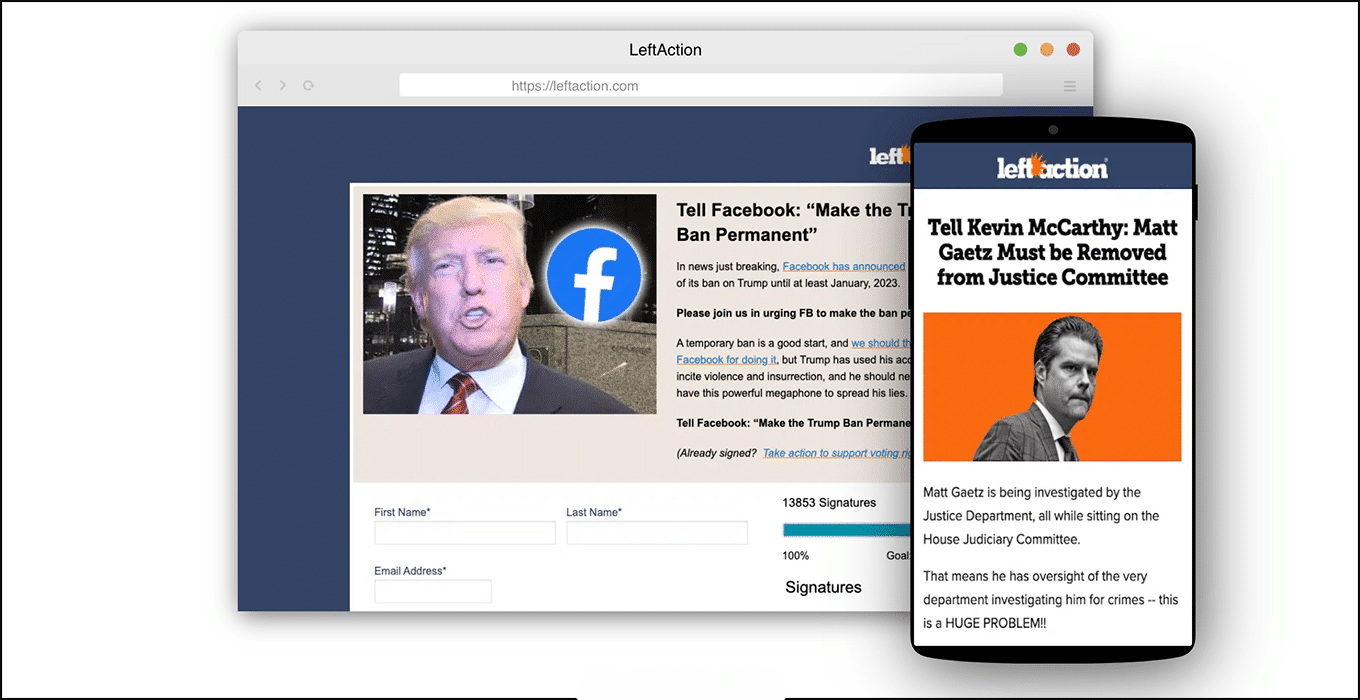
Corporate Philanthropy Campaign
Many businesses of all shapes and sizes are willing to partner with nonprofits like yours to help make a difference in the community. By launching a corporate philanthropy campaign, you can start building relationships with potential corporate partners and tap into multiple opportunities for support, such as:

- Matching gifts. Many companies will match the gifts their employees make to nonprofits at a 1:1 ratio, allowing their contributions to make twice the impact. Some may even agree upon a one-off matching gift program with your nonprofit, meaning they’ll only match gifts to your organization during a specific period of time, such as an affinity or awareness month.
- Volunteer grants. Similar to matching gifts, a volunteer grant program involves a company making a gift to your nonprofit after an employee serves a certain number of volunteer hours with your organization. Additionally, businesses may organize team-wide corporate volunteering opportunities to engage employees and build cohesion.
- Event sponsorships. A company might decide to sponsor one of your nonprofit’s events by covering some of your expenses, providing in-kind donations, and helping you craft promotional materials to secure more attendees.
Matching gift automation tools, such as 360MatchPro, make it easier than ever for your nonprofit to take advantage of the corporate giving opportunities at your disposal. Thanks to innovative features such as auto-submission, when a donor makes a gift on your donation page, all they need to do is input their corporate email address. Then, the software will automatically take care of the matching gift request on their behalf.
The Cornershop team has worked with many nonprofits, such as the Parkinson Foundation, to design and improve their donation forms, from embedding a matching gift widget to adding suggested giving levels to the page.
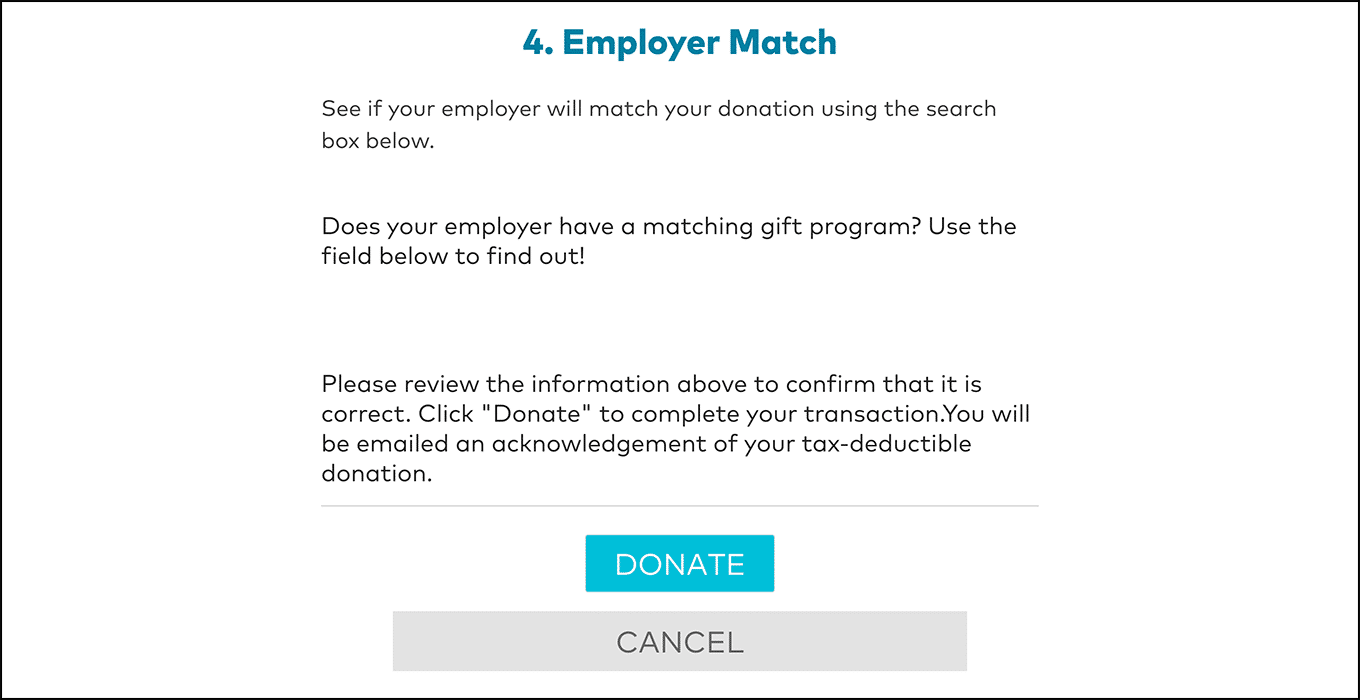
Crowdfunding Campaign
Crowdfunding campaigns are ideal for bringing in a large number of small gifts over a short period. To conduct one of these campaigns, nonprofits typically follow these steps:
- Set a crowdfunding goal and deadline.
- Design a crowdfunding page.
- Promote the campaign on various online platforms.
- Share regular updates on progress toward the goal.
Ideally, your supporters should help spread the word to ensure that you reach your goal. This type of campaign can be particularly impactful because it harnesses the power of social proof, as people are more likely to give when they see their friends and family members doing so.
On your crowdfunding page, be sure to emphasize the impact of donations and consider including a fundraising thermometer that allows donors to visualize your journey toward your goal. This ensures that you maintain momentum throughout your entire nonprofit campaign.
Peer-to-Peer Fundraising Campaign
Peer-to-peer (P2P) fundraising campaigns are related to crowdfunding campaigns. However, in a P2P campaign, each supporter gets their own fundraising page that they can promote to their family members, friends, and acquaintances on behalf of your nonprofit. To set your fundraisers up for success, it’s important to:
- Recruit dedicated supporters for your campaign.
- Provide P2P templates and graphic materials.
- Incentivize participants with small prizes.
- Check in with fundraisers regularly.
This type of nonprofit campaign can be effective for bringing first-time donors into the fold, since people may be more motivated to contribute when they’re directly asked by a loved one. Cornershop’s experts can help you level up your P2P fundraising campaign by building a dedicated microsite to house all of your campaign details and engagement features, such as fundraising leaderboards and countdown clocks.
For American University’s Giving Day, we created a new branded microsite that prioritized accessibility and facilitated participation from students and staff throughout the 36-hour fundraising event.
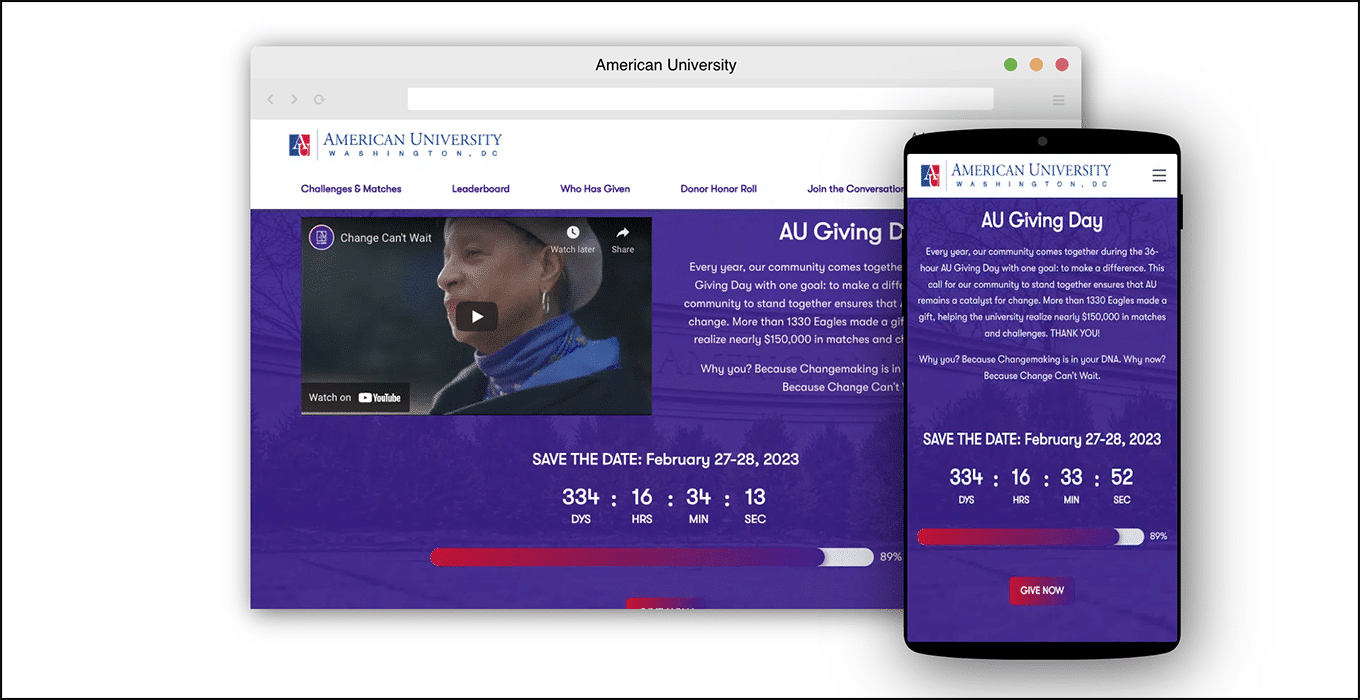
Online Fundraising Campaign
Online fundraising campaigns are extremely popular because they make it easy for donors to give with just a click of a button. Plus, you can raise more funds by reaching supporters beyond your local area. To maximize your nonprofit campaign’s results, be sure to:
- Cultivate your online presence beforehand.
- Offer a recurring gift option.
- Infuse your branding throughout campaign materials and your donation page.
- Make your donation page mobile-responsive.
When people land on your donation page, ensure that they follow through by optimizing your design. At Cornershop Creative, we’ll work with you to improve your giving process and encourage more people to complete it. When Penny Appeal Canada needed more attention-grabbing donation forms, we helped them add custom payment options, design donation receipts, and seamlessly transfer donor details into their CRM.
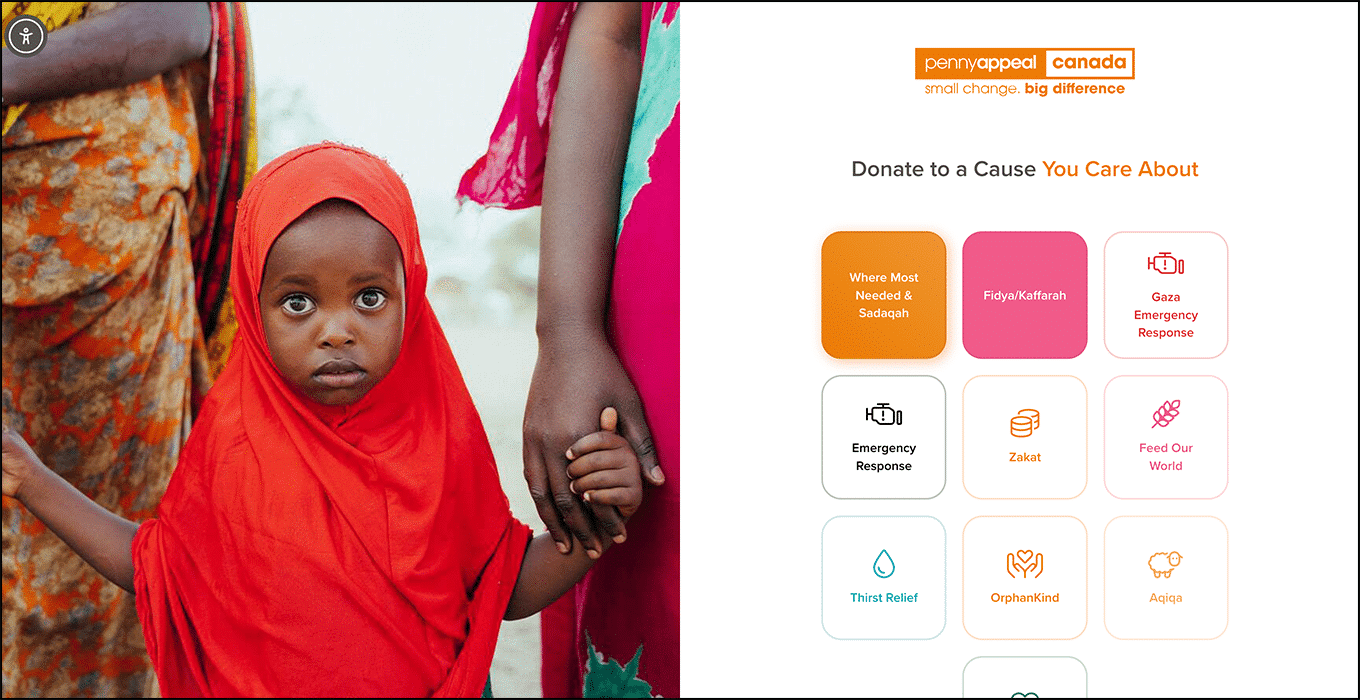
Direct Mail Fundraising Campaign
While many modern donors prefer to contribute digitally, direct mail is still a worthwhile way to reach certain supporter segments and align your online and offline outreach efforts. As you create donation request letters for your campaign, remember to:
- Personalize each letter to the recipient by mentioning their name and involvement history.
- Use impact stories to highlight how donations can make a difference in the lives of those you serve.
- Make online engagement easy by adding a link and QR code to your website.
Direct mail can provide a more personal touchpoint between your nonprofit and its donors. However, due to expenses such as postage costs, you should consider focusing your efforts on only a select number of individuals, such as your major donor prospects.
Year-End Giving Campaign
Research shows that approximately 30% of annual nonprofit giving happens in December and 12% occurs in the last three days of the calendar year alone. Launching a year-end campaign is a great way to provide one last revenue boost for your organization this year and prepare for the new year to come. Keep these tips in mind to set your nonprofit campaign up for success:
- Start planning your campaign three to six months ahead of the year-end season.
- Create donor segments to tailor your campaign messaging.
- Follow up with donors to thank them for their support.
As you reflect on your nonprofit’s accomplishments over the past year, don’t forget to share them with your community. One popular way to do this is by creating an annual report. If you’ve never built one before, or you’re looking to step up your design, our team at Cornershop is happy to help. We designed the END Fund’s annual report to match their website, including eye-catching animations and bold photos to demonstrate impact.
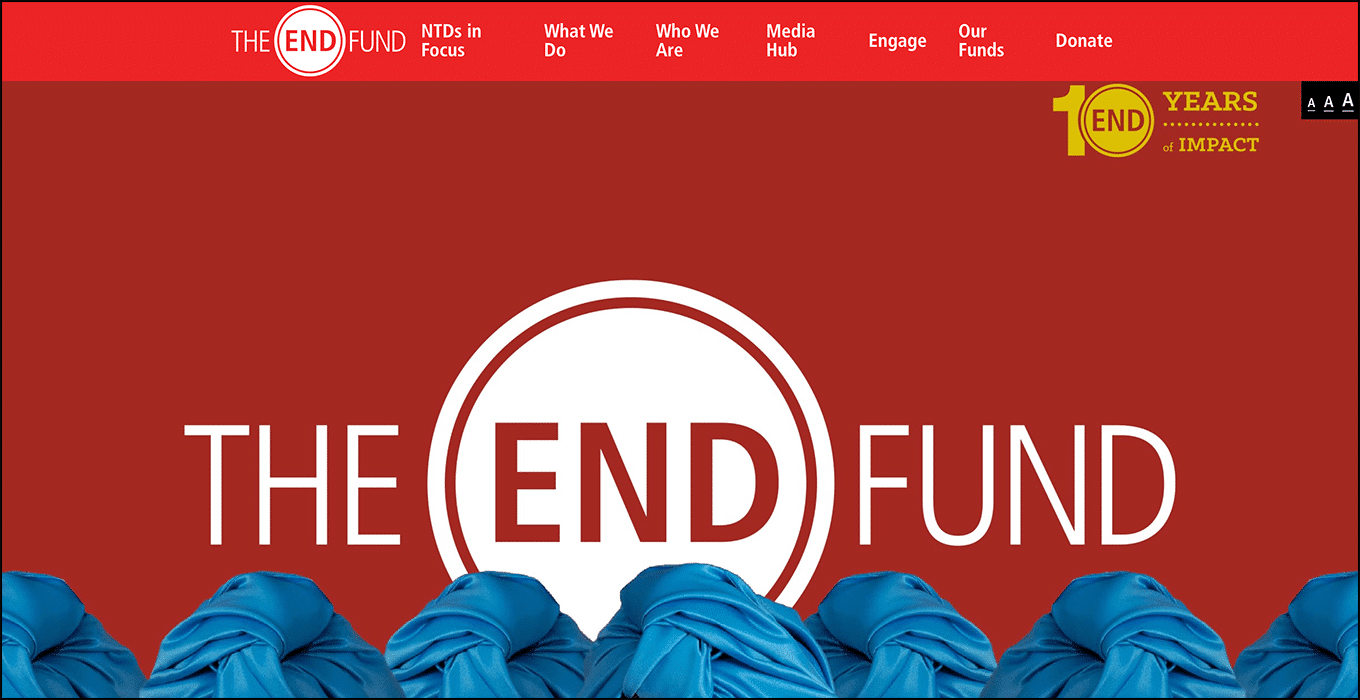
In-Kind Donation Campaign
Rather than making financial gifts, some of your nonprofit’s donors might prefer to contribute physical items or services to your cause. For instance, they might donate:
- Clothing
- Office equipment
- Technology
- Legal advice
- Accounting services
Consider your nonprofit’s mission and needs to determine which types of in-kind gifts you’ll ask for in your campaign. For instance, if you’re planning to host an auction soon, you might reach out to local businesses to see if they have any event tickets or gift cards they can contribute as auction items. To collect an assortment of in-kind donations from your community as a whole, promote this giving opportunity through channels such as your website.
Marine Toys for Tots, a nonprofit that collects and distributes new toys to less fortunate children on Christmas, reached out to Cornershop to build a new website to support their initiatives. We embedded a map that makes it easy for donors to find local chapters around the country, provided them with a style guide to apply across their pages, and created an engaging timeline that displays the nonprofit’s history.
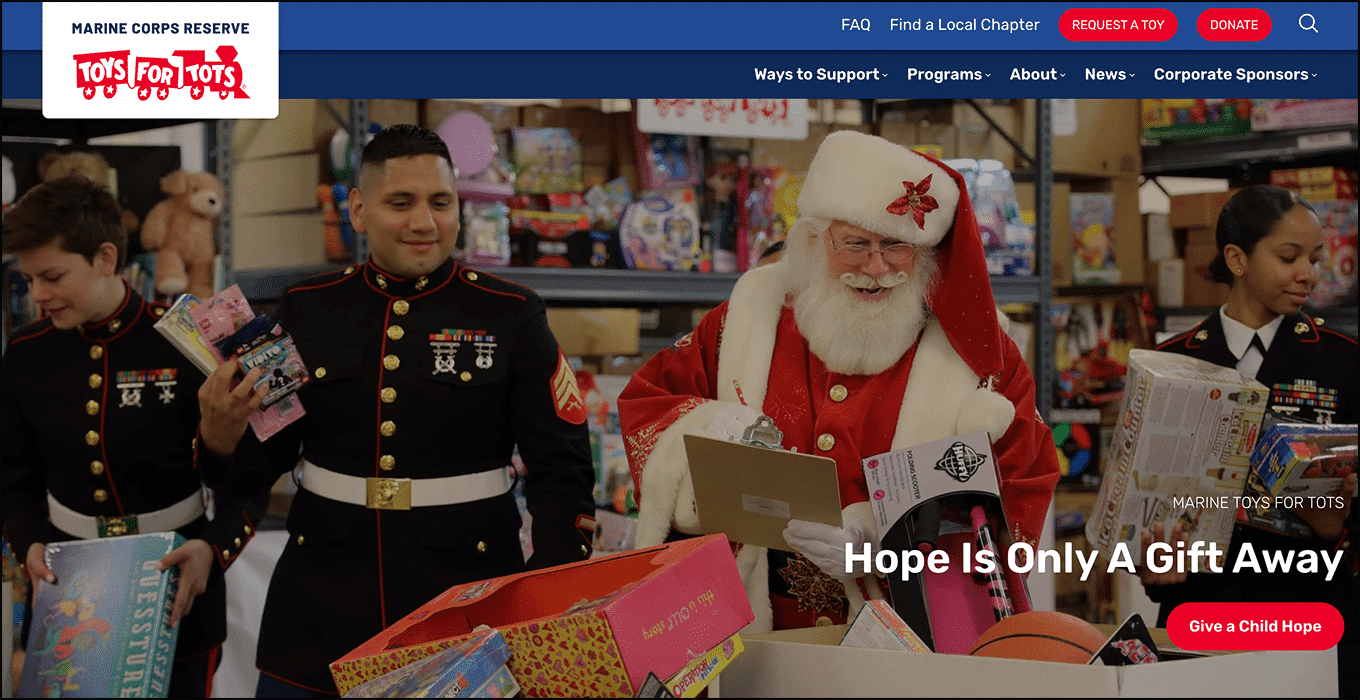
Fundraising Event Campaign
Fundraising events require careful planning to succeed. However, they’re an excellent way to gather your donor community together and strengthen your nonprofit’s relationships with them. The process of planning a fundraising event typically involves these steps:
- Determine whether the event will be in-person, hybrid, or virtual.
- Establish the budget, date, and event location.
- Market the event across numerous channels.
- Sell event tickets on your website.
Start preparing for your event somewhere between three to six months in advance. This way, you have plenty of time to figure out the logistics and promote it to your audience. Reach out to Cornershop’s team of experts if you need some marketing assistance. When the OMV wanted to maximize participation in its annual gala, we leveraged promotional emails, blog posts, website pop-ups, videos, and Facebook posts to spread the word.

Which marketing channels should I use for my nonprofit campaign?
From your nonprofit’s website to social media pages, you have so many choices in marketing channels. Therefore, the ones you focus on will depend on the goals of your nonprofit campaign. For example, you might decide to use the Google Ad Grant program to advertise your awareness campaign, since you’re trying to expand your audience to new supporters who may be interested in your cause.
Or, you may lean on social media when promoting your crowdfunding campaign, since your followers can easily share your posts with others in their network. Use multiple channels at once to reach as many potential and existing supporters as possible.
Top 4 Nonprofit Campaign Examples
As a seasoned nonprofit web design company, we’ve seen (and supported) many stellar campaigns over the years. To inspire your planning, we’ve compiled a list of top nonprofit campaign examples for you to explore:
Lymphoma Research Foundation
The Lymphoma Research Foundation’s (LRF) interactive story website is a strong model of an awareness campaign done right! After 25 years of work, a nonprofit is bound to have a lot of stories to share. LRF tells its story in style with timelines, pictures, and a compelling call to action (CTA).
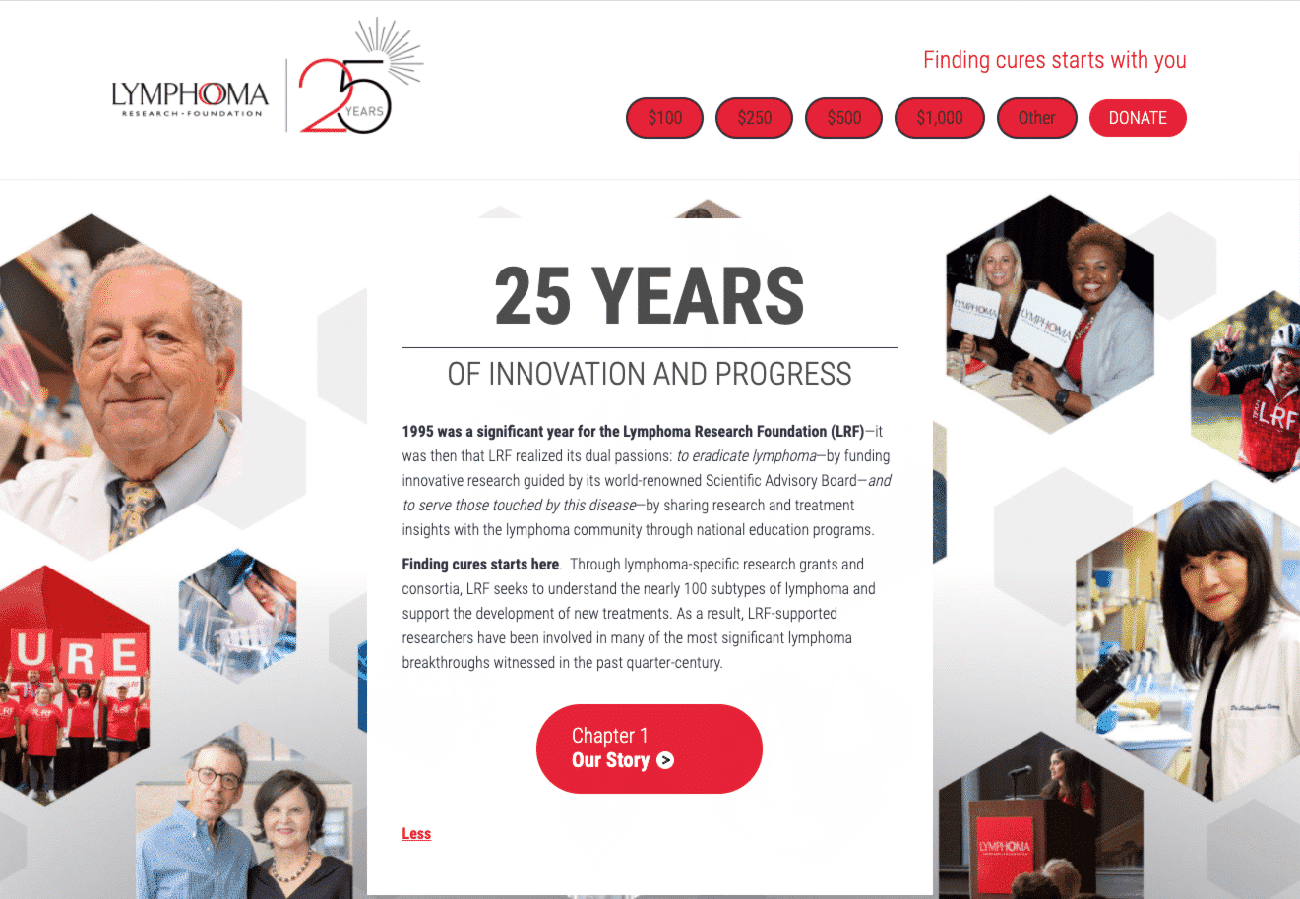
What We Love About This Campaign
- The interactive timeline is engaging and provides a clear framework for the content.
- The images are a personal yet professional way to convey the nonprofit’s story.
- The donation form at the top of the page makes it easy for supporters to imagine how they can be a part of future stories by giving today.
How Cornershop Helped
LRF reached out to our Cornershop team to design their interactive story content. We added engaging animations and transitions to appeal to readers while maintaining a consistent style with the rest of the website. Because of the results we achieved for LRF, the nonprofit later turned to us for a project to improve their online P2P fundraising experience.
League of Women Voters
The League of Women Voters puts significant effort into all of its fundraising campaigns. They collaborate with Avalon Consulting to stay on top of the latest strategic trends, then look to Cornershop for the technical support they need to make each idea a reality.
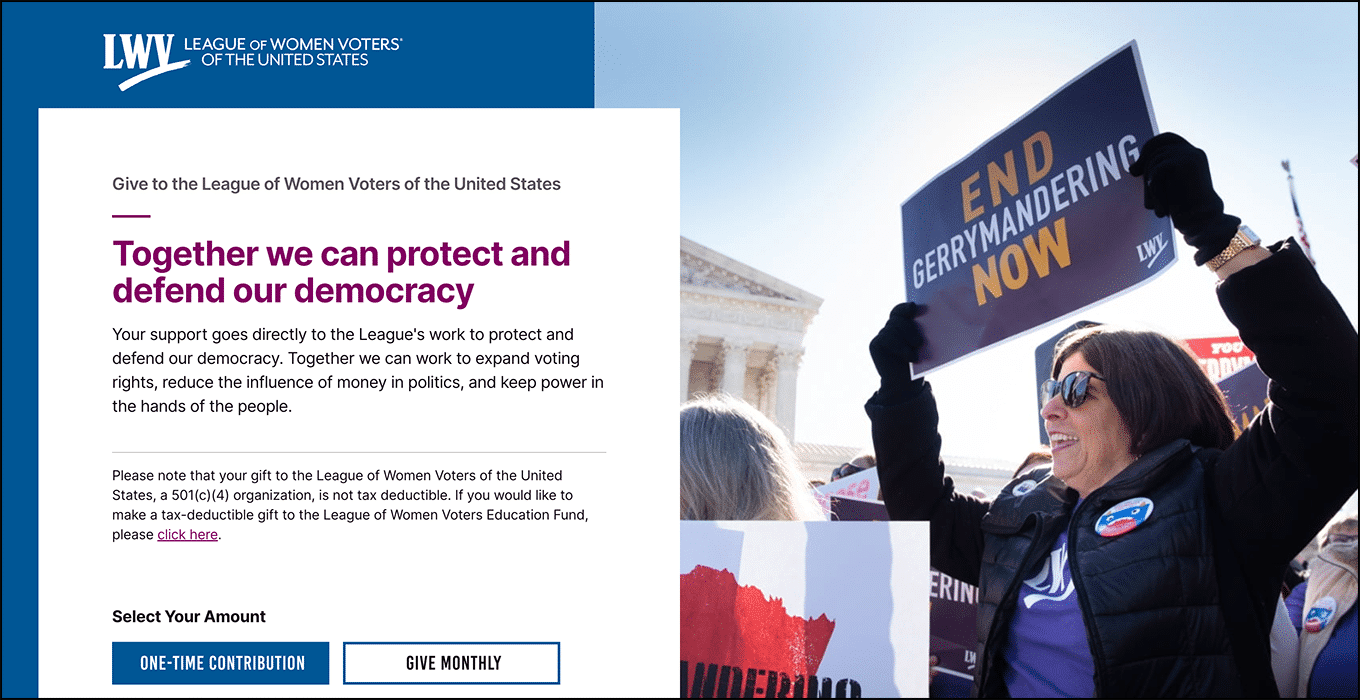
What We Love About These Campaigns
- Each campaign goes all-in with custom email templates, landing pages, and auto-responders.
- Custom graphics make the campaigns easy to recognize and fun to share.
- Emails are mobile-friendly so donors can access them on any device.
- Interactive elements, like survey forms, encourage engagement and help supporters feel involved.
How Cornershop Helped
For one of the League’s fundraising appeals, Cornershop’s experts used custom tracking codes to change the donation form ask amounts based on previous giving. When the appeals went out to around 34,000 supporters, the League managed to raise five times more than the previous appeals.
Saving Newark’s Wetlands
Save Newark Wetlands is a wonderful example of an effective engagement campaign. The Citizens Committee to Complete the Refuge (CCCR) wanted to create an action-oriented microsite to drum up more support for permanent protection and restoration of the spectacular Newark Area 4 region of the San Francisco Bay.

What We Love About This Campaign
- Using a microsite is an effective way to raise awareness about an important environmental issue and teach people about why they should get involved.
- The microsite uses powerful visuals that motivate action.
- The campaign is multi-faceted with email, donation, and action templates to quickly reach supporters and encourage them to take action.
How Cornershop Helped
To inspire involvement from more people in the CCCR’s community, Cornershop focused on building a microsite that could feature stunning images without sacrificing usability. Additionally, we produced email, donation, and action templates that matched the overall design.
Food Forward
Many people in and around Los Angeles have flourishing fruit trees in their yards—so much so that a lot of fruit was going to waste since the property owners had too much fruit for their families to consume. Food Forward decided to help distribute that extra fruit with an event called LA Fruit Share.

What We Love About This Campaign
- The event website is visually appealing, branded, and optimized for mobile.
- There is an interactive map to encourage event participation and engagement.
- All the technical elements can be reused for repeat event campaigns in the future.
How Cornershop Helped
Food Forward reached out to Cornershop’s team with a tight deadline to build a more robust website for their LA Fruit Share event, since it was rapidly increasing in popularity. We faced the challenge head-on and built an eye-catching, secure website to promote the event.
Let’s Chat About Your Project!
Best Practices for Nonprofit Campaigns
Ready to conduct your own nonprofit campaign? Use these best practices to guide you toward your goals:
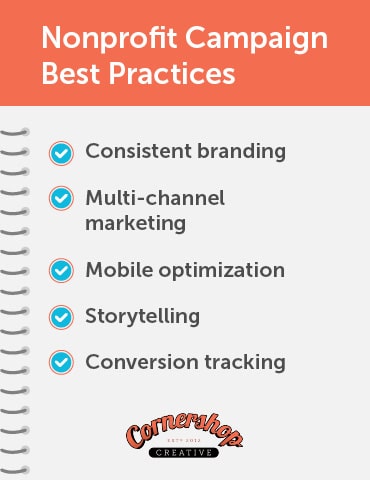
1. Maintain consistent branding.
Your campaigns don’t necessarily need to have the exact same branding as your organization, but the branding of the campaign should be consistent across all platforms. This means your WordPress site should have the same logos and typography as your emails, which should have the same color scheme as your donation forms and the graphics you share on social media.
This kind of consistency ensures that the campaign is easily recognizable, which means supporters will be more likely to trust it. Whether you use online tools to create your graphic assets or turn to professional graphic design services like Kwala, ensure that your colors, logo, and image styling all visually capture your nonprofit’s mission. Take a look at the following examples from Kwala for a better idea of how to maintain consistency across your materials:
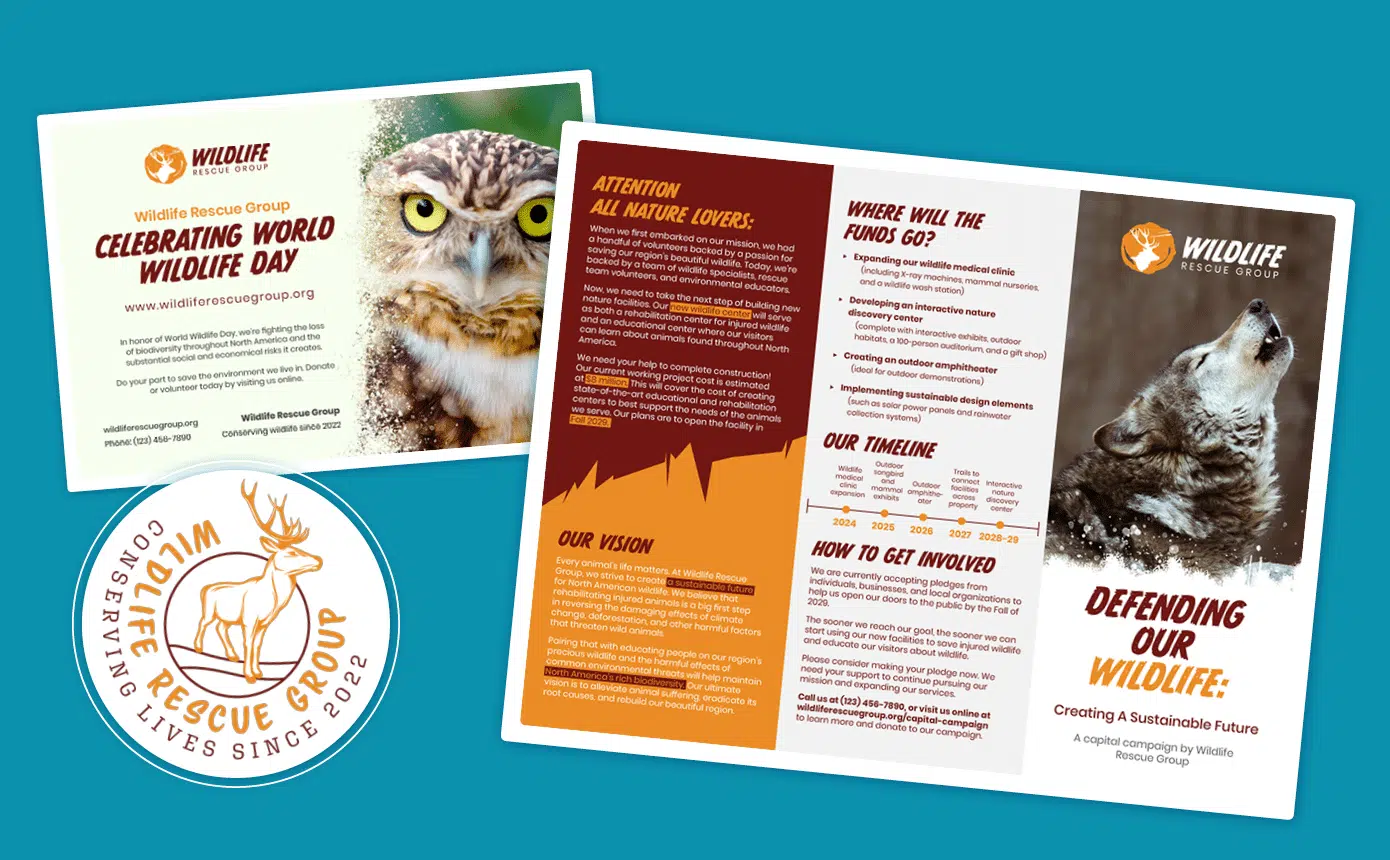
2. Use a multi-channel marketing approach.
Overstimulation is a real thing. To avoid it, most people are pretty picky about the channels they pay attention to. Some people hardly check the mailbox, but scan Facebook daily. Others may filter their email inbox to only allow work-related messages, but relax when it comes to snail mail.
This means if you are only using one marketing channel there could be a whole lot of supporters that will never see your message! To be effective, your campaigns should incorporate several of these channels:
- Website
- Social media
- Direct Mail
- Text
- Google Ads
It may seem like a lot to manage, but with some creative brainstorming, you can easily create a marketing plan for your nonprofit that includes all of the important channels and content ideas for each one!
3. Optimize digital content for mobile devices.
Did you know that over 90% of Internet users go online using their mobile devices? In fact, many people only go online with mobile devices. Mobile optimization is no longer a nice option. It is the expected norm—and we’re not just talking about your website, either. All your emails, forms, and petitions have to look beautiful and work well on mobile devices too.
Here are a few tips to keep in mind as you test the mobile-friendliness of your digital content:
- Make sure images load correctly. There is a lot that can go wrong when loading an image on mobile. Some “responsive” designs look good on tablets, but not phones, so images can be distorted or so large they run off the page. Images are also known for having large file sizes that can make them load slowly, or not at all. Test all of your digital content on multiple devices to ensure that everything looks the way you want it to.
- Ensure fonts are the right size. That huge heading font may look awesome on your actual webpage, but it will take up an entire page on mobile if it isn’t adjusted. Make sure you are building your digital content with font sizes that are appropriate for each type of device.
- Prioritize fast load time. Let’s face it, no one wants to wait around for a page to load, no matter how much we believe in the cause. Help your supporters out by making sure your digital content loads fast enough to satisfy the shortest attention span.
Make it easy for people to interact with your nonprofit whenever, wherever, and on whatever device they prefer by ensuring that your content is mobile-responsive.
4. Promote your campaigns with stories.
People love stories. We relate to them. We want to read more of them and share them with our friends and family. The best thing you can do to promote your campaigns is share stories!
Let your supporters share in personal victories by showing them the impact your organization has had this year. Let them see how they can help. It is this type of personal connection that will elevate your campaign beyond being just another marketing effort.
5. Track your conversions.
To plan more effective nonprofit campaigns in the future, you need to know what is happening with the campaigns of today—meaning you need to track all of your conversions. This can include email click rates, new subscribers, donations, and anything else that signals engagement.
By using tools such as Google Analytics to track your conversions over time, you can learn which marketing channels generate the most supporter interest, which types of content people respond to, and even which pages of your website could benefit from some quality maintenance. Without tracking, you run the risk of missing valuable growth opportunities and repeating the same detrimental mistakes over and over.
Wrapping Up
As this guide has shown, there are a lot of ways to create successful (and beautiful) nonprofit campaigns. Now it’s time to get out the whiteboard and do some creative brainstorming! What campaigns can you create to connect supporters to your cause?
One more tip before we go (and this is a big one): remember to make your campaigns unique. There is something about your organization that speaks to the hearts of the people you need to reach. Don’t be afraid to tap into that and create something brand new. Good luck!
Explore the following additional resources for more tips to elevate your nonprofit’s next campaign:
- Digital Fundraising: Ideas + Campaigns To Inspire You!. If your nonprofit campaign has a digital fundraising element, make sure to review this ultimate guide.
- Best Nonprofit Websites: 35+ Great Examples Of Online Impact. Is your website standing out from the crowd? Draw inspiration from these top nonprofit websites to take it to the next level.
- Nonprofit Email Marketing: Complete Guide and 6 Strategies. Email is a crucial tool to spread the word about your nonprofit’s campaigns. Explore email marketing in this guide!



